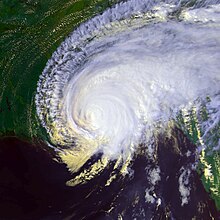 Hurricane Georges making landfall in Mississippi | |
| Tropical storm | |
|---|---|
| 1-minute sustained (SSHWS/NWS) | |
| Highest winds | 70 mph (110 km/h) |
| Lowest pressure | 970 mbar (hPa); 28.64 inHg |
| Overall effects | |
| Fatalities | 3 indirect |
| Damage | $30.1 million (1998 USD) |
| Areas affected | Southeast Louisiana |
Part of the 1998 Atlantic hurricane season | |
| History
Effects
Other wikis | |
The effects of Hurricane Georges in Louisiana included $30.1 million in damage and three deaths. Forming from a tropical wave over the Atlantic Ocean, Georges attained a peak intensity of 155 mph (249 km/h) on September 20, 1998. Over the following several days, the storm tracked through the Greater Antilles and later entered the Gulf of Mexico on September 28, the Category 2 storm made landfall in Mississippi before dissipating on October 1. Before landfall, about 500,000 residents in Louisiana evacuated from low-lying areas. The mayor of New Orleans declared a state of emergency to allow federal assistance into the state. After nearly 1.5 million people were urged to evacuate coastal areas, officials described the evacuation as "probably the largest [...] we have ever achieved".[1]
Numerous homes located outside the levee system were flooded by the storm surge, and 85 fishing camps on the banks of Lake Pontchartrain were destroyed. An estimated 160,000 residences were left without power due to Georges and severe beach erosion took place due to the slow movement of the hurricane. Precipitation statewide peaked at 2.98 inches (76 mm) in Bogalusa, and wind gusts reached 82 mph (132 km/h). In the wake of the hurricane, the Federal Emergency Management Agency (FEMA) opened 67 shelters throughout the state, and covered insurance claims totalling $14,150,532, including from Puerto Rico and Mississippi. The Clinton administration appropriated $56 million in disaster relief to regions in Louisiana for recovery from Tropical Storm Frances and Hurricane Georges.